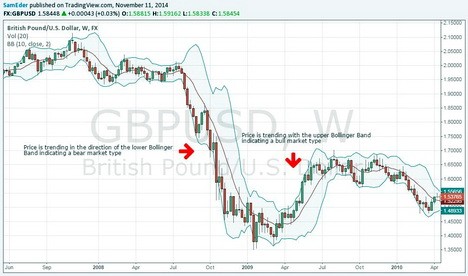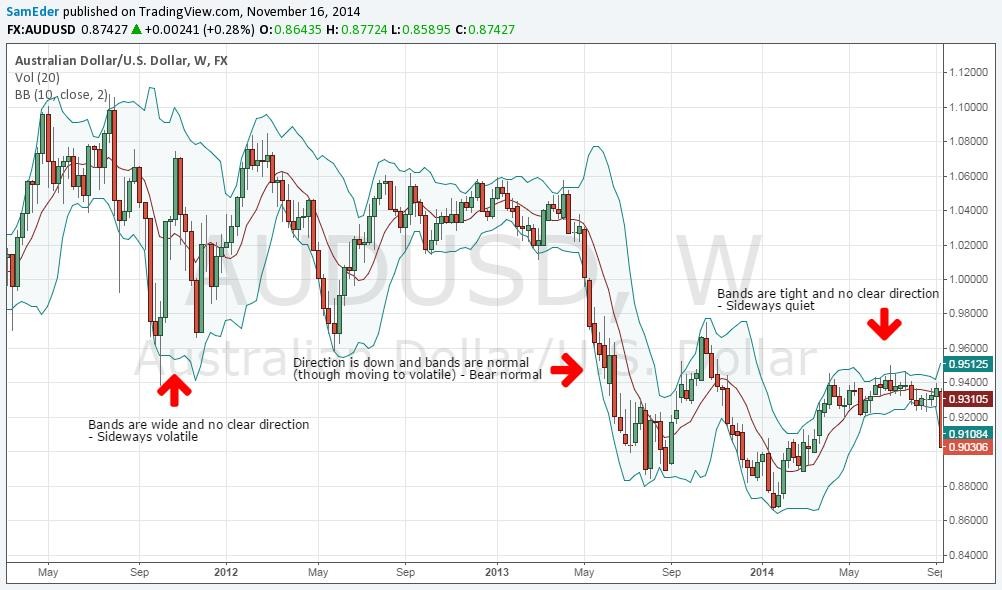Identifying Market Trends To Profit From Volatility
Post on: 12 Июнь, 2015 No Comment

There are quite a few reasons why increased market volatility is here to stay (see here for a discussion). The next step is, how can you profit from this?
We have a widely followed measure of volatility, and that is the VIX. Unfortunately, you can’t trade the VIX directly. You can either buy futures, or a host of ETF and ETN related products. Not to complicate things unnecessary, we’ll concentrate on two of them, VXX (the oldest VIX ETF) and TVIX. the relatively new daily 2X VIX ETF. TVIX gives you approximately twice the bang for your buck compared to VXX.
Mean reversal
The VIX is above 38 right now (time of writing is midday Sept. 13). That’s way above its long-term average (about 20). One of the most important things to know about the VIX is that it is mean reversing, so eventually it will get back to 20 or even below that, as can be appreciated from the figure below.
[VIX 3-year]
(Click to enlarge)
For reasons set out in our previous article. we expect an elevated VIX for some time to come, so you should perhaps try to contain your urges of shorting it.
Under normal circumstances, shorting a VIX related instrument like VXX or TVIX from elevated levels would be highly, we repeat, highly profitable. Consider for instance the figures below:
[VXX 3 year]
(Click to enlarge)
[TVIX from inception, Dec 2009]
(Click to enlarge)
[Charts courtesy of StockCharts.com]
Contango and backwardation
Apart from mean reversal, there are two other things you should know before you invest in these things. Both VXX and TVIX have a futures position with a maturity of exactly 1 month. That means, that each day they have to sell a certain amount of futures expiring first, for futures expiring the month after.
Now, this can, over time, quite drastically influence performance relative to the VIX itself, because it depends on the relative price between those to futures whether you get an extra boost, or suffer a drag on returns in these instruments. Two situations:
- Contango: futures expiring first are cheaper than those expiring the next month. This happens when the VIX is trading below average (about 20) as ‘mean-reversal’ expectations expect it to trade towards 20 over time, making futures with longer maturities more expensive. If you’re long in VXX (let alone TVIX), this is a drag on performance (roll yield is negative), but if you short it, it boost your returns.
- Backwardation. Futures with shorter maturity being more expensive than those with longer maturities. This usually happens when the VIX is high, as means-reversal is expected to take the VIX down in the future. If you’re long in VXX (let alone TVIX), this provides a boost to returns (that over time can really become important), if you short it, it works against you.

So to give you some stages in the bull market — bear market cycle:
- Plain bull market. In a bull market you have a falling VIX and (unless coming from a very high level) the VIX will normally experiencing contango, which is a drag on long positions (in VXX or TVIX). Shorting these will be very profitable.
- Stagnant at the top. In a relatively quiet stagnant market, shorting VXX or TVIX is usually still attractive, the VIX won’t move too much and contango will be the friend of the shorts over time.
- Correction. Shorting here is not such a good idea as a rising VIX will more than compensate an left-over contango, and contango itself will narrow and could shift into backwardation the more violent the correction is, in which case we move towards in stage 4.
- Turbulent bear market. In a falling and turbulent market (needless to say the two usually, but not always go together), a rising VIX is usually a much stronger force than backwardation, so a long VXX or TVIX position will be (very) profitable.
- Quiet bear market. If the market violence subsides both the VIX and backwardation will fall and especially when we’ve reached Market bottom. backwardation shifts into contango, at which point shorting VXX or TVIX will give you a double boost from falling VIX and contango alike and we’ll be in stage 1 again.
In the figures above (VXX and TVIX performance) you see stage 1 after inception of the bull market starting in March 2009. Both VIX reduction and ensuing contango made shorting them an almost insanely profitable strategy.
However, from May to August you see stages 2 and 3, with VXX and TVIX swinging directionless and only with the market fall, increased volatility and moving into backwardation giving longs a terrific return.
All very well, the reader might think, but:
- In what market stage are we in now?
- How do we know it will last?
The latter question is the most simple, we don’t know. Nobody does.
How to profit now
We think we’re in a market where volatility will remain elevated for some time to come, stocks will gyrate but on the whole probably not go a lot higher (or much lower) and there is the possibility of some cataclysmic market event (bank failure, euro debt implosion, much stronger recession, take your pick).
We believe that in this climate, a small long position in one of the volatility instruments (VXX, TVIX) is an attractive, although by no means safe (especially TVIX) opportunity. If the market doesn’t go higher and volatility doesn’t subside, backwardation is likely to stay which gives you a positive roll-yield if you’re long.
On top of that, you have some market protection for if things really go bad. The VIX will spike and backwardation open up further. It is important that you sell on these spikes (you might even go short, although that’s not without risk if the spike worsens) because they’re not likely to last.
One more consideration, you can swing trade these things (VXX and especially TVIX). Go long after some days of market rally, and sell after the near inevitable correction in this manic depressive market. As long as you don’t expect to get in at the (relative) bottom and out at the (relative) top, you’ll do fine. There are even plenty of people who do this on an intra-day basis, but that is even more art than science.














